California blaze erupts near site of deadliest US wildfire
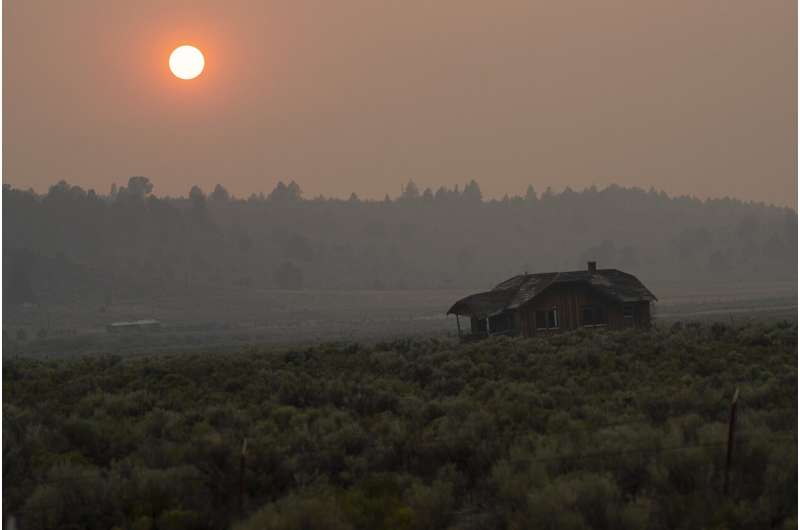
A blaze that erupted near the flashpoint of the deadliest wildfire in recent U.S. history was heading away from homes on Thursday but survivors of the 2018 blaze in the town of Paradise worried that history could repeat itself.
The Dixie Fire had burned 3.5 square miles (9 square kilometers) of brush and timber near the Feather River Canyon area of Butte County and moved into national forest land in neighboring Plumas County.
There was zero containment, however, and officials kept in place a warning for residents of the tiny communities of Pulga and east Concow to be ready to leave.
In its early hours, the fire raced along steep and hard-to-reach terrain about 10 miles (16 kilometers) from Paradise, the foothill town that was virtually incinerated by the Camp Fire that killed 85 people.
Larry Peterson, whose home in neighboring Magalia survived the previous blaze, said some of his neighbors were getting their belongings together in case they had to flee.
"Anytime you've got a fire after what we went through, and another one is coming up, you've got to be concerned," he told KHSL-TV.
Other locals stocked up on water and other items.
"We pretty much left with our clothes on our backs" during the previous fire, said Jennifer Younie of Paradise. "So this time we are looking to be more prepared and more vigilant."
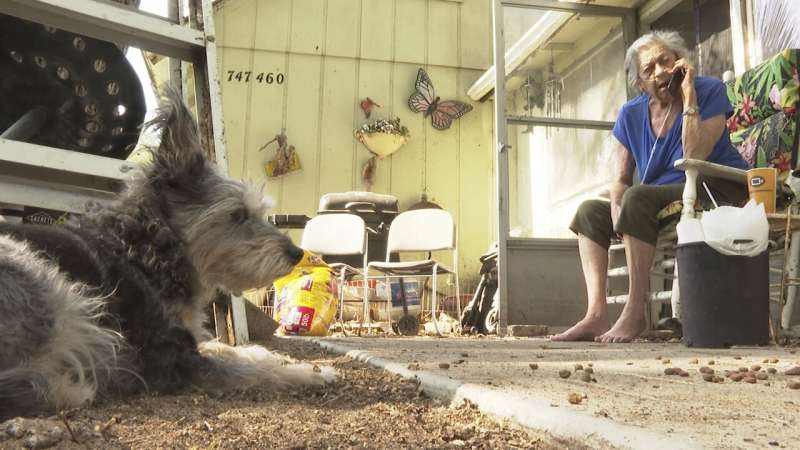
Joyce Mclean's home burned last time but she has rebuilt it and will again if necessary, she told the station.
"We just take each day as it comes and if it happens, it happens," Mclean said. "There's not much that we can do about it."
Ironically, the blackened scar of the previous blaze was standing between the fire and homes.
"Everything's pretty much burned between them and the fire," Butte County Supervisor Bill Connelly told the Sacramento Bee. "Some bushes and grass have grown back, but it's probably not a direct threat at this time."
The blaze is one of nearly 70 active wildfires that have destroyed homes and burned through about 1,562 square miles (4,047 square kilometers)—a combined area larger than Rhode Island—in a dozen mostly Western states, according to the National Interagency Fire Center.
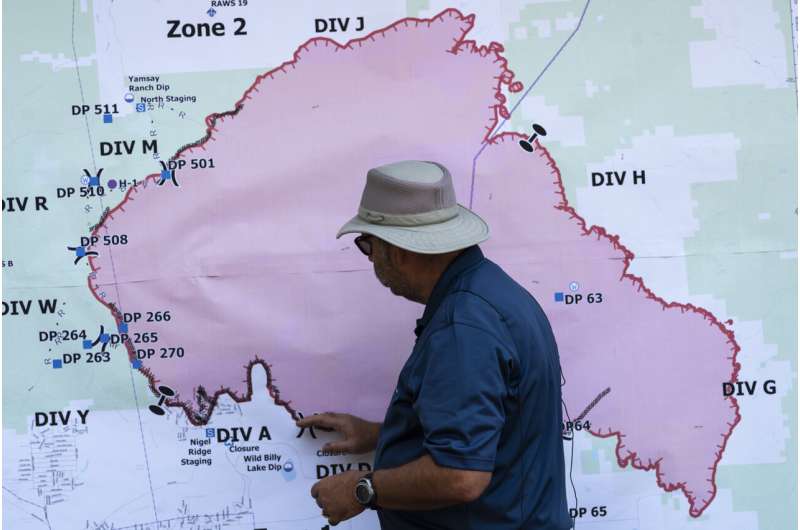
In southern Oregon the Bootleg Fire, the largest wildfire currently burning in the U.S., covered more than 355 square miles (919 square kilometers) early Thursday after a day of extreme behavior and explosive growth. Twenty-one homes have been destroyed and another 1,900 remained threatened in the Fremont-Winema National Forest area just north of California that's been gripped by a historic drought.
"This fire is going to continue to grow—the extremely dry vegetation and weather are not in our favor," Joe Hessel, an incident commander, said in a statement.
The nearby Log Fire, which originated as three tiny fires on Monday, ballooned to more than 7.5 square miles (19 square kilometers) as winds pushed the flames eastward through wilderness.
Tim and Dee McCarley could see trees exploding into flames in their rearview mirror as they fled the fire last week at the last minute. They had put off their departure to pack more belongings and search for their missing cat.
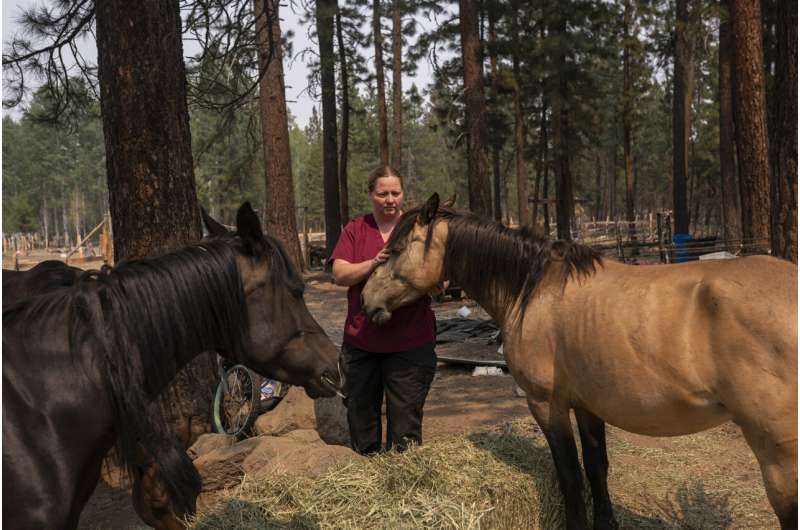
"The sheriff's department had been there and they said, 'If you don't get out of here now, then you are going to die,'" said Tim McCarley, 67, as he, his wife and stepson rested Wednesday at a shelter at the Klamath County Fairgrounds.
"We were running around like a chicken with its head cut off, throwing stuff into the car. Then we say, 'Okay, that's it … we got to go."
Tim McCarley was allowed to return briefly after the fire had passed over their rural community northwest of Bly. He found his home still standing and their cat inside unharmed. But the flames had crept within 5 feet (1.5 meters) of their house, the heat melting their trailer and storage units until they looked "like a melted beer can," he told The Associated Press in a phone interview.
The National Weather Service tweeted late Wednesday that a "terrifying" satellite image showed gigantic clouds fueled by smoke and hot air had formed over the fire—a sign that the blaze was so intense it was creating its own weather, with erratic winds and the potential for fire-generated lightning.
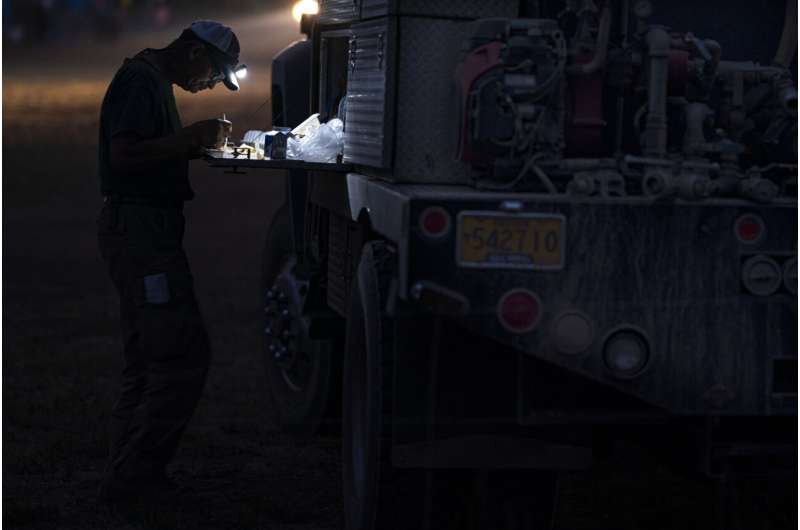
"Please send positive thoughts and well wishes to the firefighters. ... It's a tough time for them right now," the tweet read.
Extremely dry conditions and heat waves tied to climate change have swept the region, making wildfires harder to fight. Climate change has made the American West much warmer and drier in the past 30 years and will continue to make weather more extreme and wildfires more frequent and destructive.
An extreme heat wave late last month sucked vegetation dry in the Pacific Northwest, where firefighters say they are facing conditions more typical of late summer or fall than early July. The Northwest Interagency Coordination Center moved the region up to the highest alert level Wednesday as dry gusts were expected in some areas and new fires popped up.
In California, the state's largest fire so far this year grew to 156 square miles (404 square kilometers) north of Lake Tahoe near the Nevada state line.
-
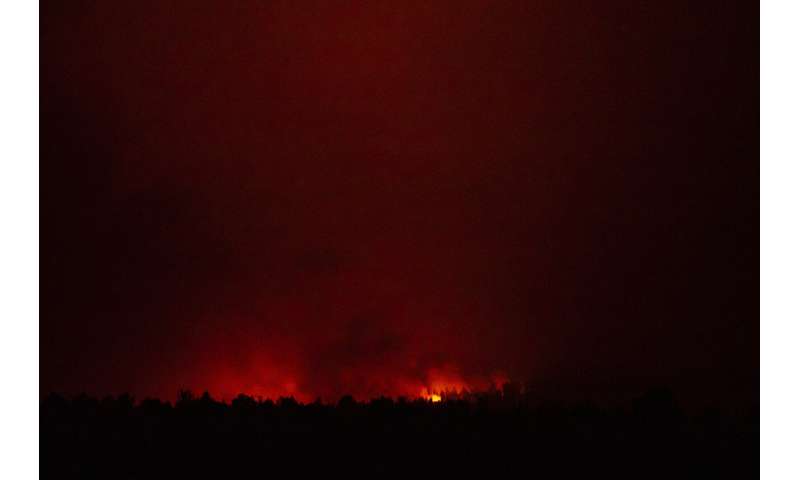
Fire from the Bootleg Fire glows in the distance on Tuesday morning, July, 13, 2021 near Bly, Ore. An army of firefighters is working in hot, dry and windy weather to contain fires chewing through wilderness and burning homes across drought-stricken Western states. A high-pressure system that created the second intense heat wave of the year is weakening Tuesday, but temperatures are forecast to remain above normal on the lines of more than 60 active large fires. Credit: AP Photo/Nathan Howard -
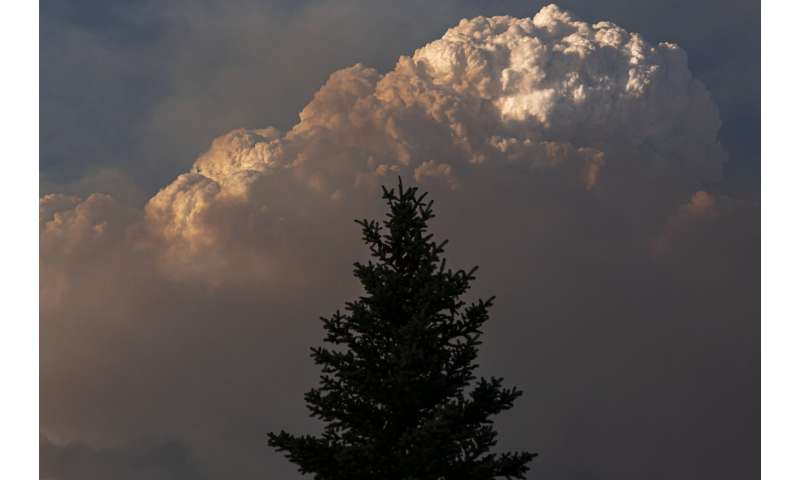
The Bootleg Fire smoke plume grows over a single tree on Monday, July, 12, 2021 near Bly, Ore. An army of firefighters is working in hot, dry and windy weather to contain fires chewing through wilderness and burning homes across drought-stricken Western states. A high-pressure system that created the second intense heat wave of the year is weakening Tuesday, but temperatures are forecast to remain above normal on the lines of more than 60 active large fires. Credit: AP Photo/Nathan Howard -
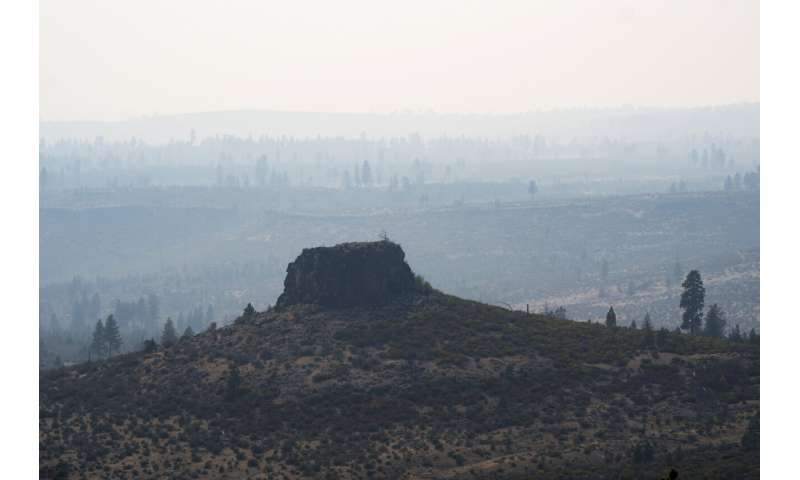
Smoke fills the air near the Bootleg Fire, Tuesday, July 13, 2021, near Sprague River, Ore. Credit: AP Photo/Nathan Howard -
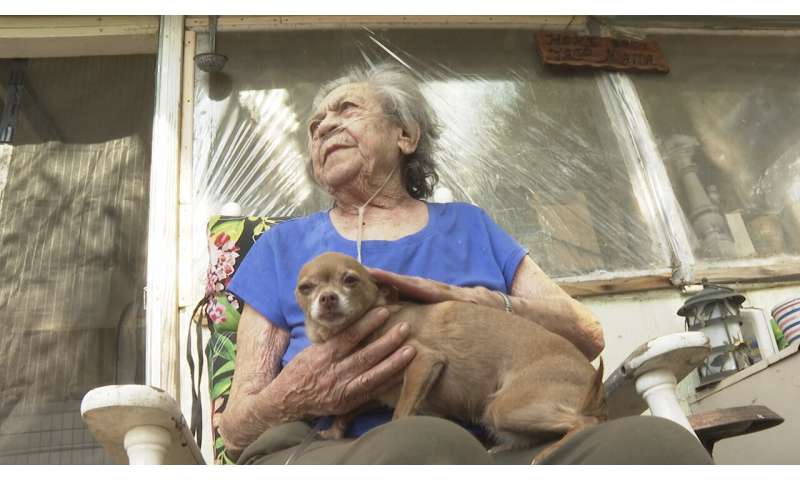
Beverly Houdyshell, 79, who's home burned down sits at her granddaughter's house in Doyle, Calif. on Tuesday, July 13, 2021. Houdyshell, said Tuesday that she's too old and too poor to rebuild and isn't sure what her future holds. "What chance do I have to build another house, to have another home?" Houdyshell said. "No chance at all." Damage was still being tallied in the rural community of Doyle, Calif., where flames swept in during the weekend and destroyed several homes, including Houdyshell's. Credit: AP Photo/Haven Daley, File -
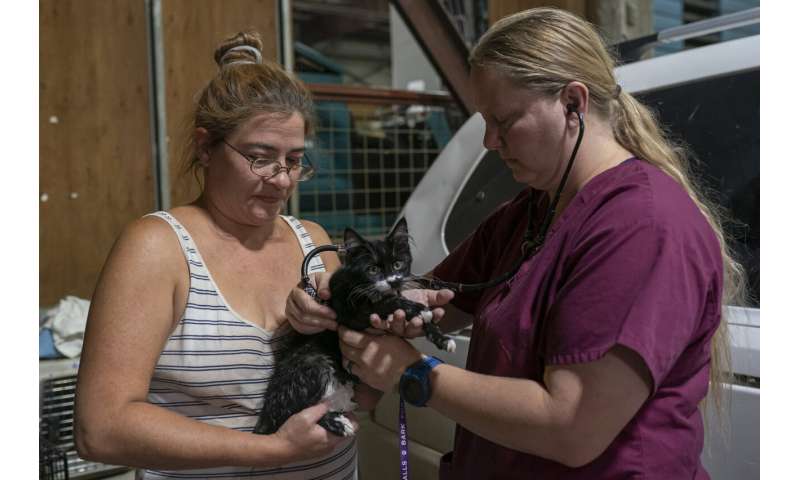
Kim Berge, left, holds her kitten River for an examination by veterinarian Tawnia Shaw after evacuating to a Red Cross shelter near the Bootleg Fire on Tuesday, July, 13, 2021 in Klamath Falls, Ore. A high-pressure system that created the second intense heat wave of the year is weakening Tuesday, but temperatures are forecast to remain above normal on the lines of more than 60 active large fires. Credit: AP Photo/Nathan Howard -
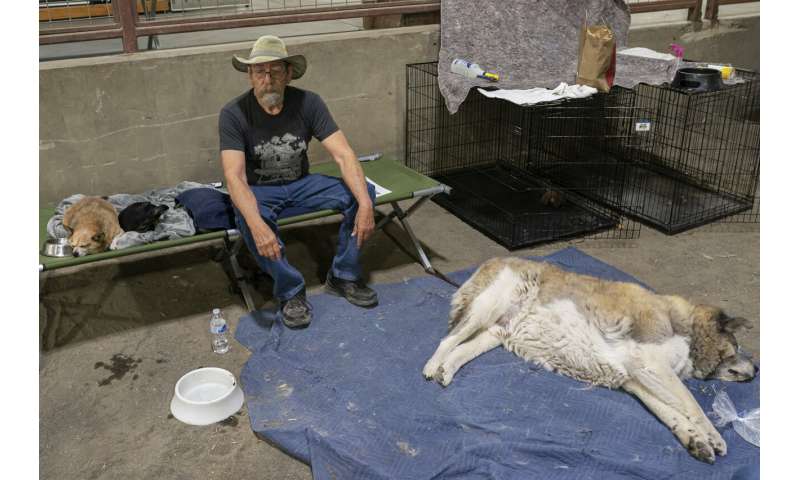
Art Garcia and his dog Shiro rest after evacuating to a Red Cross shelter near the Bootleg Fire on Tuesday, July, 13, 2021 in Klamath Falls, Ore. A high-pressure system that created the second intense heat wave of the year is weakening Tuesday, but temperatures are forecast to remain above normal on the lines of more than 60 active large fires. Credit: AP Photo/Nathan Howard -
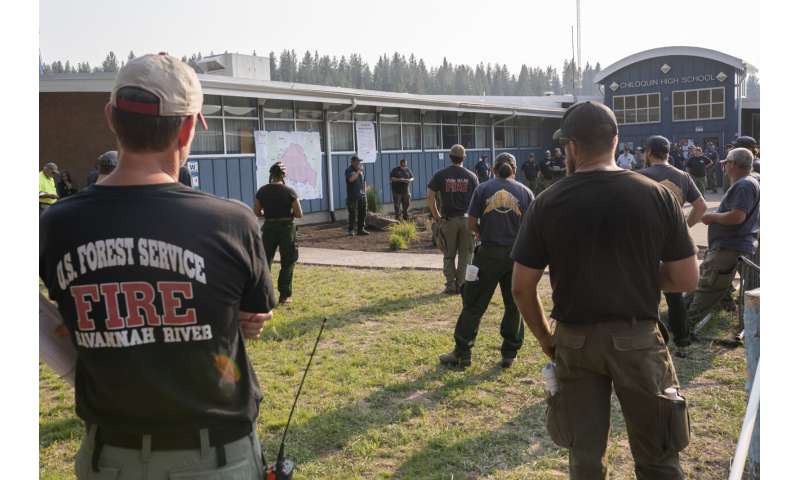
Firefighters from Oregon and other nationwide agencies meet at Chiloquin High School before heading toward the Bootleg Fire, Tuesday, July 13, 2021, in Chiloquin, Ore. Credit: AP Photo/Nathan Howard -
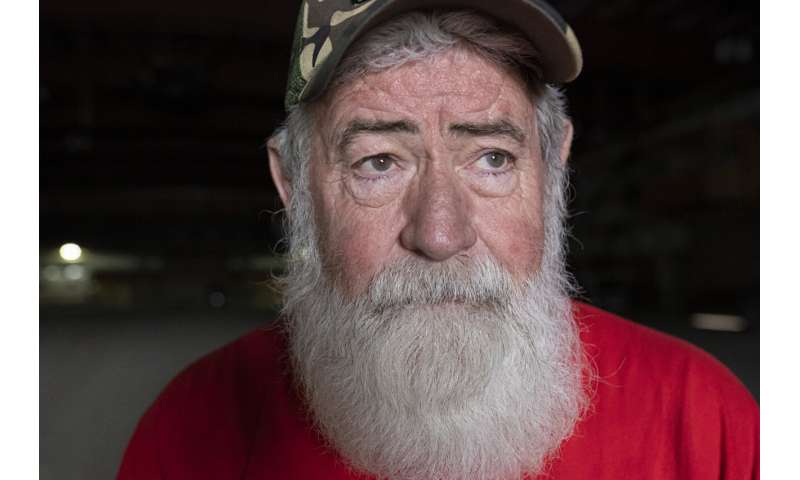
Tim McCarley talks about their evacuation from the Bootleg Fire while at a Red Cross center on Wednesday, July 14, 2021 in Klamath Falls, Ore. Credit: AP Photo/Nathan Howard -
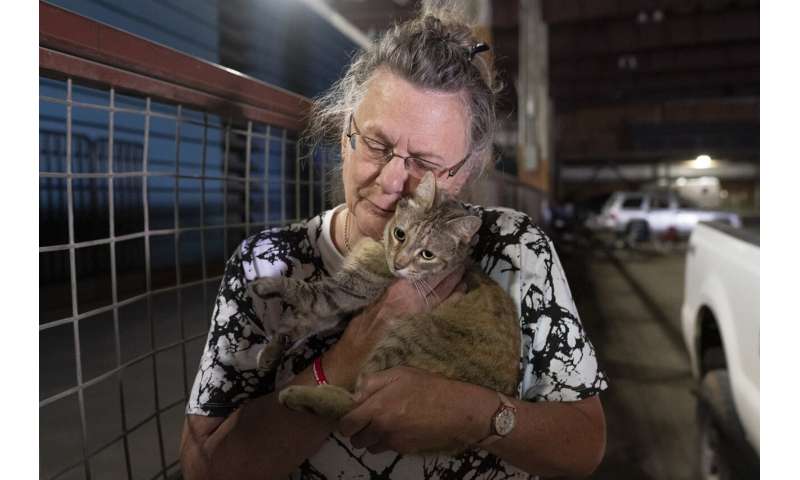
Dee McCarley hugs her cat Bunny, whom she took with her while evacuating from the Bootleg Fire, while at a Red Cross center on Wednesday, July 14, 2021 in Klamath Falls, Ore. Credit: AP Photo/Nathan Howard
The Beckwourth Complex, a merging of two lightning-caused blazes, was 68% contained but new evacuations were ordered on the north side as winds carried embers ahead of the fire, Plumas National Forest officials said Thursday morning.
The fire "has been creating its own independent weather patterns as the day progresses," a statement said.
A wildfire threatening more than 1,500 homes near Wenatchee, Washington, grew to 14 square miles (36 square kilometers) by Thursday morning and was about 10% contained, the Washington state Department of Natural Resources said.
About 200 firefighters were battling the Red Apple Fire near the north-central Washington city renowned for its apples. The fire was also threatening apple orchards and an electrical substation, but no structures have been lost, officials said.
© 2021 The Associated Press. All rights reserved. This material may not be published, broadcast, rewritten or redistributed without permission.




















